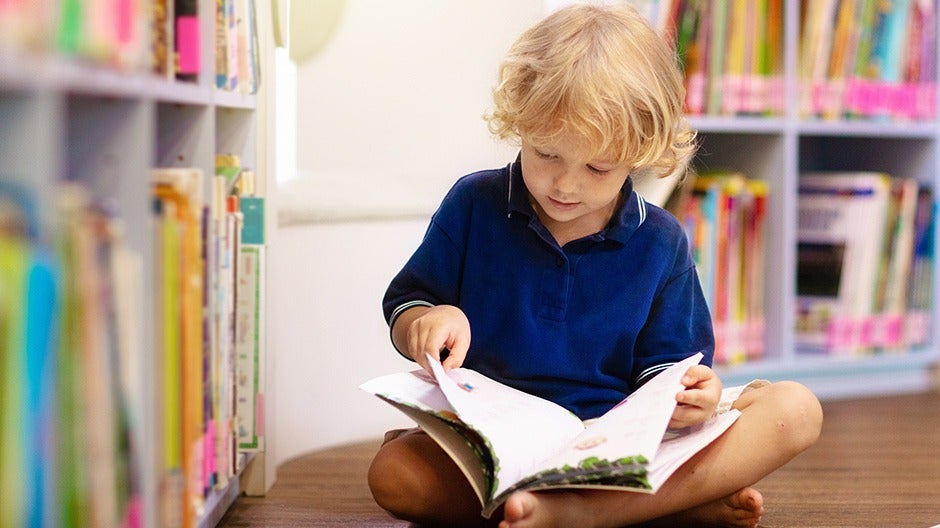What Are Pre-Reading Strategies?
Pre-reading strategies are learning approaches designed to help give your child structure, guidance, and background knowledge before they begin exploring a new text.
These strategies target your child’s reading comprehension skills by giving them the tools they need to become active, successful readers.
By activating the knowledge your child already has about certain subjects, learning how to utilize context clues, and talking with you about the book, they’ll be on their way to reading and writing scholarly essays in no time!
Basic Pre-Reading Strategies

As the name suggests, pre-reading strategies are used before you begin reading a book with your child. There are a few main strategies you can use to help your child prepare to dive into any story. Let’s take a look!
Previewing
By this, we don’t mean Googling the movie-adaptation trailer (although that might be a fun way to compare and contrast the text later on!).
Previewing means letting your child gather clues — from the book’s title and cover illustrations, inside illustrations, and maybe the table of contents for older children — to try to figure out what might happen or what they might learn in a book they are about to hear or read.
Purpose
If you have time, it’s always great to put aside a moment for mindfulness before reading with your child. Talk with them about what reading goals they still want to achieve.
Do they still need help with longer words (pronunciation)? Do they want to work on their character voices (expression)? Getting their input will help you both come together to set a goal — or purpose — for your reading time.
Predictions
Using the resources available to your child, see if they can make predictions about what might happen in the story before they get a chance to read anything.
What information can they gather just using the title, cover, and illustrations? Then you both might continue predicting as the story unfolds.
8 Pre-Reading Activities To Try At Home

1) Speaking In Questions
This is a fun activity that helps your child become more insightful about the text they’re reading while letting them be silly, too! The goal here is for your child to investigate the things they want to know, might know, or aren’t sure about just by looking at the cover of the text.
We know you probably use the question-and-answer format quite a bit in your reading routine, so this offers your child a nice change of pace. Instead of you asking the questions, they get to ask, too!
These questions can be silly or straightforward. For example, if you’re reading Goldilocks and The Three Bears, you could start the question conversation by asking your child, “Why do you think her name is Goldilocks?”
Your child might ask back, “Why do these bears live in a house?” See how many questions you can come up with.
It’s OK if these questions are not answered right away. Most of them will probably be answered once you’ve finished reading the book! Any that go unaddressed can always be answered afterward.

2) K-W-L-H Chart
This pre-reading activity was invented and made famous by Donna Ogle back in the 1980s. The different letters in K-W-H-L charts represent different tasks for your child to complete with you.
The “K” column is reserved for things your child already knows about the subject of a book or its story. The key here is activating and then reflecting on their prior knowledge. For example, if they’re reading Charlotte’s Web, what do they already know about pigs and spiders?
The “W” category is for what your child wants to know about the story. What are they curious about?
The “L” (what they learned from the story) and “H” columns (how they can find out more ) are reserved for discussing after you’ve finished reading.
The last row, how they can find out more, is more important in nonfiction than fiction — although after reading Charlotte’s Web, you could find out more about spiders by seeking out a nonfiction book.
While this exercise is traditionally completed by writing their answers down on a chart, we think it’s more fun to get physical with it!
For example, you could make a book review video to share with family members! First, challenge yourselves to come up with at least six Ks and 6 Ws, three from each of you.
Next, make a video that begins by naming the book you are reading, followed by announcing the things you know and the things you want to know. When you are finished with the book, video what you learned and where you can go to learn more.
You can even create a special book-video library of your KWLH experiences!
3) Pre-Teach Vocabulary
If you know that the book you’ll be reading together will challenge your child’s current reading skills, consider teaching them a handful of the more challenging words ahead of your reading time.
We love a good old-fashioned game of (reverse) Charades for this pre-reading activity. To start, you might write out the word you want your child to learn on a large sheet of paper. Make sure to use bold, thick letters!
Then, try and act out the definition of the word for your child. Based on your impeccable acting skills, they can guess the definition of this new word!

4) Pre-Teach Themes
Many children’s books set out to teach children more than new words. They usually have moral lessons embedded in their pages as well.
For example, themes might include things like the power of friendship in Charlotte’s Web or courage in a book about Martin Luther King, Jr.
To get your child’s mind focused on the theme of the book, you could prompt them by discussing the same moral lesson. See what their initial opinion is about it. Do they have a strong sense of it already, or do they want to learn more?
Reading the book can either confirm or change their opinion. And then you have something to talk about when you’re finished reading!
5) Word Bingo
This game is another great option for getting your child’s mind prepped to learn vocabulary or to brush up on sight words they need a little extra help with.
If you’d like to try this pre-reading activity, create a Bingo sheet for each of you using words from the text before your reading time. Every time you or your child hears or sees a word that matches one on your sheet, place a sticker on it.
The first one to yell out, “Bingo!” wins.

6) Sentence Obstacle Course
This pre-reading activity is great for encouraging your child’s comprehension and sentence formulation. The stronger grasp they have on learning how to construct words into sentences, the faster they’ll adjust to the flow and structure of stories.
For this exercise, we suggest writing down several words on individual sheets of paper. Make sure you include all the components of a typical sentence — nouns, adjectives, objects, and verbs. Only include one word per piece of paper.
Next, scatter the words on the ground. We suggest adopting the “the floor is lava” rule! Your child will need to hop to different words to combine them into a sentence.
For example, they could “write”: The (jump) cat (jump) is (jump) red. If you want them to work on their punctuation, you could include that, too!
7) Anticipation Vs. Reality
This method will help take some of those preliminary questions you and your child came up with and figure out what happens in the end!
For this game, you can play while reading or beforehand. If you want to make guesses about what will happen in the story before reading, make sure you jot them down on a piece of paper to keep track of who made the most correct guesses.
If you want to play during the story, you can ask questions to prompt your child before turning to a new page. For every correct guess they make about what happens next in the story, they earn a tally point.
The goal is for your child to get as many points as they can!
8) Origin Story
For children who seem to show an interest in history, this might be the perfect pre-reading activity.
There are so many things you can learn from books just from discovering a little bit about their backgrounds. For example, tons of writers pull from their real lives for inspiration to write their books.
Finding out about an author’s life in the author’s blurb and maybe even searching out more information either before or after reading can be a learning adventure all on its own!
To do this activity, work with your child to see what you can find out about the story you’ll be reading (without spoiling the ending!). What you can learn based on the author, where they are from, where the story is based, its historical period, and its subject matter?
This helps your child build additional knowledge and gets them prepared for the story ahead!
Pre-Reading Strategies For The Win

Pre-reading strategies are all about getting your child prepared for the reading journeys to come. We hope these eight ideas will help you both have interesting, exciting conversations about books and where they can take you!
And if you ever need a little helping hand in the meantime, check out our personalized Learn & Grow App for reading exercises and adventures that will keep your child entertained, energized, and learning!












